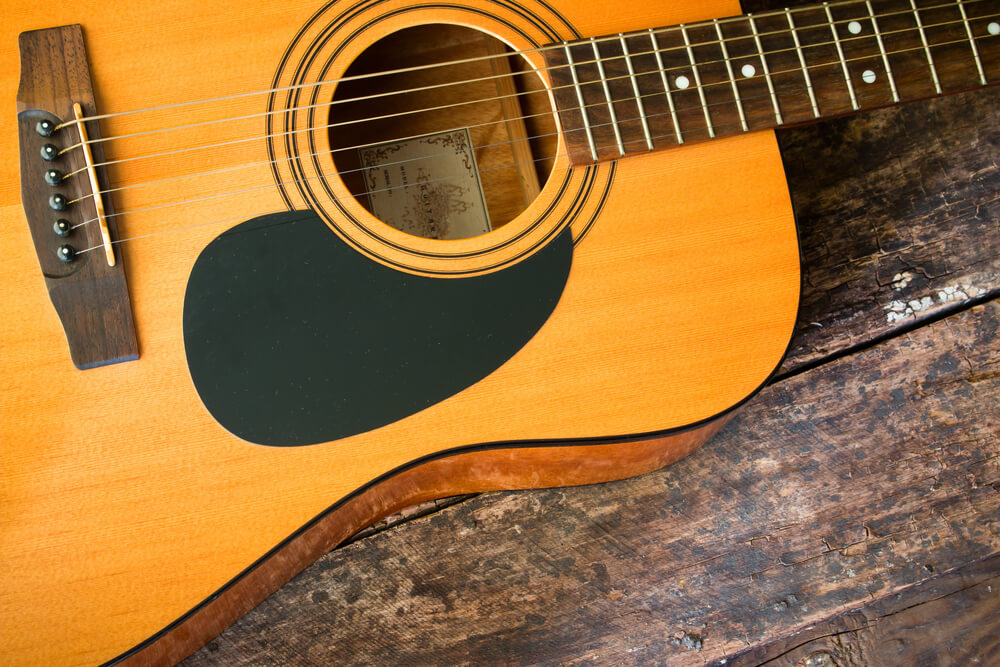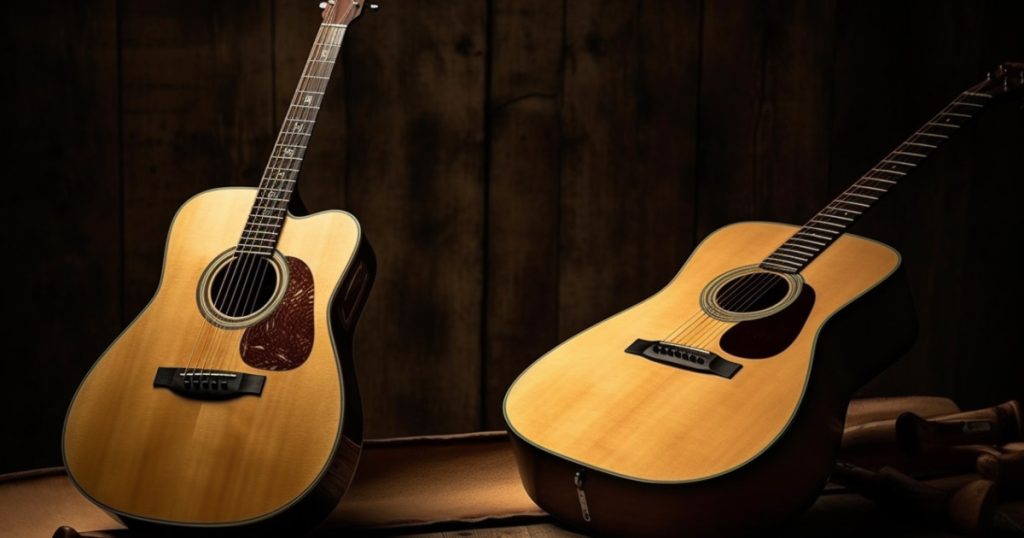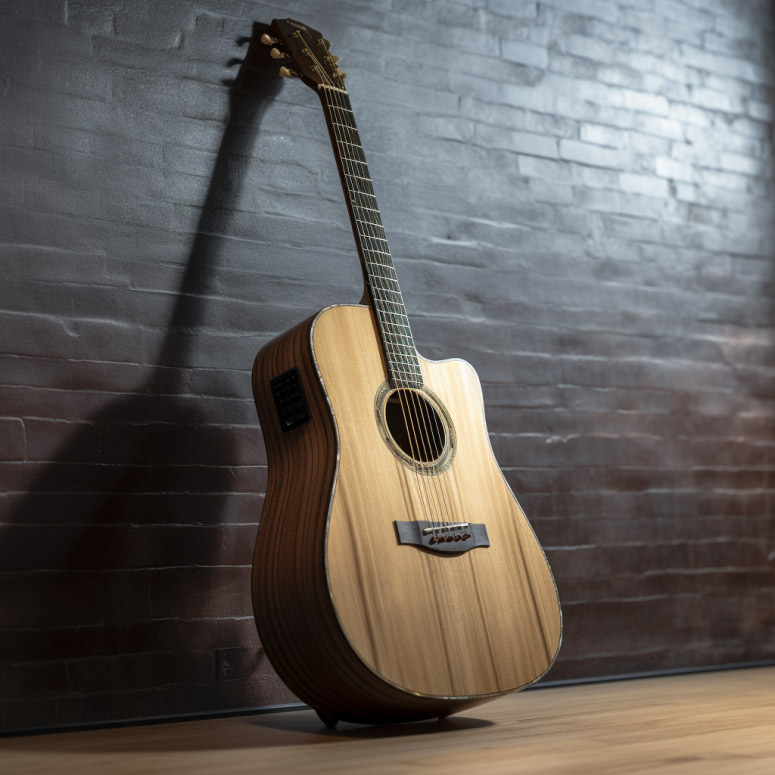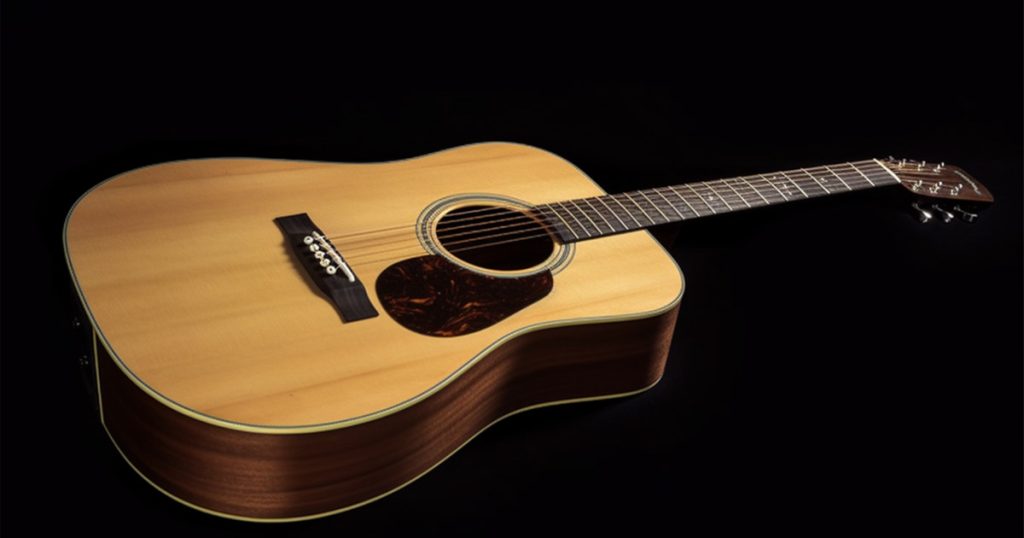From the hands of legendary musicians like Bob Dylan and Johnny Cash to the stages of modern artists like Taylor Swift, the dreadnought guitar has proven to be an incredibly versatile and powerful instrument. But what is a dreadnought guitar?
With its rich sound and adaptability, it comes as no surprise that this type of guitar has become a favorite among musicians across various genres. In this blog post, we will explore the unique features of the dreadnought guitar, compare it to other acoustic guitar styles, and help you choose the right one for your playing needs.
Before we delve deeper, here is a concise comparison table to clarify the key differences:
| Factor | Acoustic Guitar | Dreadnought Guitar |
|---|---|---|
| Size | Generally smaller | Larger body |
| Sound Volume | Moderate | Louder |
| Bass Response | Less prominent | Stronger |
| Tonality | Bright, clear | Full, rich |
| Ideal Music Genres | Versatile, suits many | Folk, bluegrass, rock |
Short Summary
- The dreadnought guitar is renowned for its full sound and versatility, popularized by well-known artists.
- It features a large body size, square shoulders, a bold tone, and exceptional craftsmanship.
- Various models are available to suit different playing styles with top brands including Martin, Taylor & Epiphone offering varying budgets.
Understanding the Dreadnought Guitar

The dreadnought guitar, named after the large HMS Dreadnought battleship, is the most popular type of acoustic guitar, known for its size and simple design. First produced by Martin in the early 1900s using rosewood for a bright, rich tone throughout, the dreadnought guitar quickly gained popularity among musicians due to its powerful sound and versatility.
Famous dreadnought players include Bob Dylan, Johnny Cash, and Taylor Swift, who all took advantage of the instrument’s unique tonal characteristics and adaptability.
Key Features
The most notable features of the dreadnought guitar include its large body size, square shoulders, and bottom. The neck is typically attached to the dreadnought body at the fourteenth fret, allowing for easy access to higher notes.
The first dreadnought guitar produces a bold and full tone, suitable for both strumming and fingerstyle playing. Popular models among Martin dreadnought guitars are the D-18 and D-45, both known for their exceptional sound quality and craftsmanship.
Famous Dreadnought Players
In addition to the previously mentioned musicians, other renowned dreadnought guitar players include Jimmy Page, Elvis Presley, Ben Howard, Del McCoury, Peter Rowan, Father John Misty, Rivers Cuomo, and Seth Avett. These artists have mastered the dreadnought guitar and used it to create some of the most iconic music in history.
The dreadnought’s sound and versatility make it an ideal choice for any genre, proving its worth as a timeless instrument.
Comparing Acoustic Guitar Styles

Dreadnought guitars are just one of the many styles of acoustic guitars available to musicians. Concert guitars, for example, are smaller than dreadnoughts and provide a balanced tone with clear bass notes and fewer overtones.
Classical guitars, on the other hand, have nylon strings and are well-suited for fingerstyle playing. Jumbo guitars are typically louder and more popular in Nashville and rock scenes. Each style offers its own unique sound and characteristics, making the choice of body type of an acoustic guitar dependent on the player’s preferences and playing style. (More about Dreadnought Vs. Classical Guitar).
Concert Acoustic Guitars
Concert guitars are characterized by their smaller body size and well-defined curves. Their design results in a balanced mid-range tone with remarkable clarity. These guitars are commonly used by beginner acoustic guitar players, as their smaller size makes them more comfortable and accessible to learn on.
The sound of a concert guitar is distinctly different from that of a dreadnought. Concert guitars have a reduced bass presence and tend to emphasize crisper highs and mids. This focused sound makes them a solid choice for singer-songwriters, as they don’t produce too much noise that would compete with vocals and other instruments.
Classical Acoustic Guitars
Classical acoustic guitars are another popular choice among musicians. These guitars are typically smaller in size and feature nylon strings instead of steel strings, producing a softer, more mellow sound. The wide neck of a classical guitar is designed to accommodate fingerstyle playing, making it an excellent choice for those who prefer intricate picking techniques.
Dreadnought Guitar Variations
Aside from the standard dreadnought guitar, there are several variations that cater to the specific needs and preferences of guitar types musicians. These include cutaway dreadnoughts, which feature a design that allows for easier access to higher frets.
Acoustic-electric dreadnought guitars, which come equipped with most acoustic guitars but with electric components for amplification, and hybrid dreadnoughts that combine both cutaway and acoustic-electric features.
Cutaway Dreadnoughts
The cutaway feature in dreadnought guitars is a design innovation that facilitates access to higher frets on the guitar, which is particularly beneficial for lead guitarists. This design allows players to explore a wider range of notes and create more interesting chords or solos in their music.
The cutaway feature is available in a variety of dreadnought models and brands, offering versatility and convenience to players who seek easier access to the upper frets of the body style of their instrument.
Acoustic-Electric Dreadnoughts
Acoustic-electric dreadnought guitars are versatile instruments that combine the rich sound of an acoustic guitar with the convenience of an electric guitar body and components, such as pickups, preamps, and EQs. These guitars are suitable for both recording and live performances, making them a popular choice among musicians who require amplified sound without sacrificing the tonal qualities of an acoustic instrument.
Brands like Martin, Gibson, and Fender offer a range of acoustic-electric dreadnought guitars to cater to various playing styles and budgets.
The Dreadnought Guitar’s Sound and Versatility
The dreadnought guitar is known for its huge sound and adaptability, making it a popular choice among musicians of various genres. Its rich, warm, and bold tones can be attributed to its large body and unique design.
Moreover, the dreadnought guitar is suitable for a wide range of playing styles, such as strumming, flatpicking, and fingerstyle accompaniment, further cementing its status as a versatile and powerful instrument.
Tonality and Projection
Dreadnought guitars are renowned for their deep and full tone with a subtle midrange scoop. They possess a rich and powerful low end, which has made them a favorite among bluegrass musicians and other genres that require a pronounced bass presence.
The dreadnought’s tonality and powerful projection make it an ideal choice for performing in larger venues, further contributing to its popularity among live performers.
Suitability for Various Playing Styles
The versatility of the dreadnought guitar allows it to accommodate a broad range of playing styles and genres, including rock, country, blues, and bluegrass. Its powerful sound and ability to generate a wide range of tones make it an excellent choice for musicians looking to explore different styles or experiment with new techniques.
Furthermore, the dreadnought guitar is suitable for both solo playing and accompaniment, making it a solid choice for any musician.
Choosing the Right Dreadnought Guitar
Selecting the right dreadnought guitar involves considering factors such as price range, quality, and the top brands available in the market. Brands like Martin, Gibson, Fender, and Ibanez offer a variety of dreadnought guitars to suit different playing styles and budgets.
By taking into account your personal preferences, playing style, and the context in which you will be using the guitar, you can make an informed decision and find the perfect dreadnought guitar for your needs.
Price Range and Quality
Dreadnought guitars come in a wide range of prices, from budget models to high-end instruments. Generally, the higher the price, the greater the quality of the guitar. However, there are some budget models available that still provide good quality and sound. When choosing a dreadnought guitar, it is essential to consider your budget and the level of quality you desire in an instrument.
It is important to note that the type of wood used in the construction of the guitar can also influence its price. For example, guitars made with solid wood tend to be more expensive than those made with laminated wood. However, solid wood guitars generally produce a richer and more resonant sound than their laminated counterparts.
By considering the materials used in the construction of the dreadnought guitar, as well as the price range and quality, you can make an informed decision and find the perfect instrument for your needs.
Top Dreadnought Guitar Brands
When choosing a dreadnought guitar (here you can see my best dreadnought guitars), it is essential to consider the top brands available in the market. Martin, Taylor, Epiphone, Yamaha, Gibson, Takamine, and Guild are some of the leading dreadnought guitar brands, each offering their own unique sound and style. These brands provide a selection of models to accommodate varying playing styles and budgets, ensuring that you can find the perfect dreadnought guitar to suit your needs.
Martin dreadnought guitars are renowned for their bright, clear tone and excellent projection, while Taylor guitars are known for their warm, balanced tone and wide range of sounds. Epiphone and Yamaha guitars offer affordability and a wide range of sounds, while Gibson, Takamine, and Guild guitars are celebrated for their warm, balanced tone and use of premium materials and craftsmanship.
By considering the top dreadnought guitar brands and their unique characteristics, you can make an informed decision and find the ideal instrument to suit your playing style.
Summary
In conclusion, the dreadnought guitar is a versatile and powerful instrument that has become a staple in the world of music. With its rich sound, adaptability, and suitability for various playing styles, it is an ideal choice for musicians across different genres.
By understanding the unique features of the dreadnought guitar, comparing it to other acoustic guitar styles, and considering factors such as price range, quality, and top brands, you can make an informed decision and find the perfect dreadnought guitar to elevate your playing experience. So, what are you waiting for? It’s time to pick up your very own dreadnought guitar and start making beautiful music.
Frequently Asked Questions
What is the difference between a dreadnought and regular guitar?
The primary difference between a dreadnought and regular guitar is their size. Dreadnought guitars have larger bodies, producing a loud sound that is perfect for playing in bands, while regular guitars have smaller bodies that produce a quieter sound better suited for solo play.
Therefore, the type of guitar you choose depends on the purpose you intend to use it for.
What are dreadnought guitars good for?
Dreadnought guitars offer a large and full sound ideal for strumming chords and fingerpicking. With their deep bass and punchy mid-range, they are perfect for singer-songwriters looking to project their sound without losing any sonic clarity.
They provide plenty of volumes and a strong tone for powerful performances.
Is a dreadnought guitar good for beginners?
Given its easy playability, classic look, and affordable price, a dreadnought guitar is an ideal choice for beginners. With its Venetian cutaway body and rolled fingerboard edges, it enables players to access higher frets more easily, making it great for those looking to progress with their playing.
It is also a great choice for those who want to play a variety of styles, from blues to rock and jazz. The dreadnought shape produces a loud, balanced sound that is perfect for strums.
Why are guitars called dreadnought?
Guitars of the 1900s were small and quiet, but C.F. Martin & Co. created a larger model that was louder and more powerful than any guitar before it. Named after the World War I British battleship HMS Dreadnought, these guitars embody the same strength and power as the ship, which is why they are called dreadnoughts.
The name serves to demonstrate the craftsmanship and robustness of these guitars, which have become a standard for acoustic guitarists everywhere.




